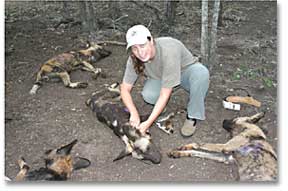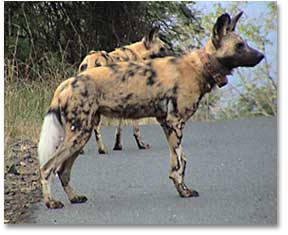|
|
 The tabulators |
|
The wild-dog woman at Humboldt
by JESSICA CEJNAR
One day Micaela Szykman Gunther was in her Toyota Land Cruiser following a clan of 80 hyenas through the African bush when, crossing a gully, she came across a leopard tearing at a fresh wildebeest carcass. Her hyenas, not noticing, continued across the gully and up a hill -- all except the last male, who crept over to the carcass.
"Ordinarily leopards and hyenas would be pretty well matched, but leopards are shy and they usually defer to hyenas," said Gunther, relating the tale one day this fall while sitting in the house she rents from Humboldt State University at the Wright Wildlife Refuge. "This leopard had clearly worked really hard to kill this wildebeest and was also very hungry, because when the hyena came to steal it, he would not let him have it."
 For
the next few minutes the hyena and leopard played tug-of-war
with the wildebeest, until the hyena had had enough and began
eating from his end of the carcass.
For
the next few minutes the hyena and leopard played tug-of-war
with the wildebeest, until the hyena had had enough and began
eating from his end of the carcass.
"They would each try and pull it away, and [then] they would feed together, and [then] pull away," she said. "Anytime I saw competing carnivores feed together on a carcass -- I also saw hyenas and lions feeding occasionally together -- was pretty amazing."
HSU Professor Micaela Szykman Gunther with some of the rare wild dogs of Africa: tranquilized before reintroduction (right), and alert (below).
That wasn't so very long ago, and she is still very much in touch with the wildlife in Africa. But at the moment, as Humboldt State's newest Wildlife Department faculty member, the 34-year-old Gunther is ensconced at the six-acre Wright Refuge, near Eureka, where she is dealing with a different set of wild animals. A black bear is known to make frequent visits, although Gunther hasn't caught a glimpse of it yet. Deer have found her garden, and the foxes come around. But perhaps the biggest menace is the skunk that took up residence under the house one Sunday night and decided to spray.
 "[The smell
made the house] almost unlivable," said Gunther, one of
her frequent smiles taking up her whole face. "It made us
like wildlife a little bit less."
"[The smell
made the house] almost unlivable," said Gunther, one of
her frequent smiles taking up her whole face. "It made us
like wildlife a little bit less."
But that's probably still more than most people. Inside the refuge house, which Gunther shares with her husband Glenn -- a native of Johannesburg, South Africa, whom she met while working with wild dogs -- is a veritable stuffed-animal safari: 10 hippopotamuses sit on the couch with a couple of spotted hyenas and an African wild dog. More wild dogs, with their oversized ears and dark muzzles, smile from around the room, inviting you to play. And 10 more dogs in a large painting behind the couch show their backsides as they walk onto a shimmering savanna. Amid the furry visages are other mementos, including an intricately beaded Maasai necklace, of Gunther's days as a conservationist and wildlife manager in Africa.
Gunther spent much of the past nearly 15 years there, first studying the reproductive behavior of spotted hyenas at Kenya's Masai Mara National Reserve as a graduate student, and then, as a postdoctoral fellow with the Smithsonian Institution, in South Africa's Hluhluwe-iMfolozi Park reintroducing the endangered African wild dog to areas it hadn't been in 50 years.
But her love for animals began in Great Neck, New York, where she grew up. In fact, she can't remember a time when she didn't love animals.
"My mom says as soon as I could walk, I would wander off, following the neighbor's cat and the neighbor's dog," she said.
Her mother and father, immigrants from Italy and Belgium respectively, weren't animal lovers. Her father was a demographer at the United Nations, researching sociology and family planning issues for developing countries. Her mother taught Italian language and literature, and now teaches opera students at Juilliard how to sing in Italian. Between them, and visits to Europe to visit family, Gunther and her older brother learned to speak English, French and Italian. And that, she says, helped her fit in and learn Swahili when she got to Kenya.
Gunther first set foot in Kenya in 1992, when she entered a program to study wildlife in Africa. It was a turning point for her -- up until then, she'd been preparing to become a veterinarian, something she'd wanted to be since she was 6 years old. She'd worked from age 15 at an animal shelter, progressing from "cleaning up after really messy puppies" and kittens to de-worming and vaccinating them, and was already a vet tech by the time she entered Amherst College in Massachusetts. But she itched to see more of the world.
"[Amherst College] was pretty supportive of study abroad programs," she said. "But as a biology pre-vet, you couldn't just go to Australia and take classes in art. It just wasn't going to work. You couldn't get enough science credits." So when she learned about the wildlife program in Kenya, she jumped for it.
"That's what totally turned my life around," Gunther said. "I found out that you could study wildlife and not be a vet, and that you could make a career out of either behavior, which is really my interest and is what I do now, [or] also ecology and conservation."
Three weeks after she returned from her first year in Kenya, she went back as a teacher's assistant for the summer, and again three years later for her doctorate research under Michigan State University zoology professor Kay Holekamp. It was Holekamp who turned Gunther onto hyenas. "She taught us that hyenas were great hunters and live in these complex social societies and they were really smart," Gunther said.
And that's how Gunther found herself, that day, following behind that clan of 80 hyenas and suddenly spying the leopard with its wildebeest kill. She was conducting graduate research as part of a larger, 20-year study. "We would go out and find hyenas at the den and we would identify all the individuals and record their behaviors," Gunther said. "We would spend every morning and every evening out following our clan of hyenas."
Her attraction for hyenas soon led to an attraction for African wild dogs. Both species are stigmatized and misunderstood, Gunther says. But while hyenas are abundant to the point where they are considered vermin in some places, wild dogs are extremely rare. According to the Smithsonian's National Zoo's website, there are only about 5,000 wild dogs left in Africa. If you went on safari in South Africa, you would have a better chance of seeing a cheetah or an elephant.
"A lot like wolves in the U.S., [wild dogs] were persecuted and hunted out of almost all their ranges throughout Africa," Gunther said. Wolves have been brought back to a few places in the United States because of changing attitudes toward them. "I'd say that in Africa we're trying to make that same transition happen, and the program I've been involved with is actually a reintroduction program to bring wild dogs back to areas they once roamed."
Gunther's first African wild dogs reintroduction took place in 2004. A plane was sent to pick up the dogs at one park and take them to uMkhuze Game Reserve in South Africa. Gunther met the plane as it landed. Thirteen sleeping wild dogs waited inside to get reacquainted with an area that hadn't seen them in half a century. Gunther and her colleagues put radio collars on the dogs so they could be monitored, and allowed them to settle into their new area for six months to form a new pack in captivity before they were released into the wild.
"Packs are formed when a group of brothers and a group of sisters come together from different packs," she said. "We try and simulate that. We'll put a group of sisters from one park on one side of the enclosure and we'll put a group of brothers on the other. If it's done correctly, the males and females won't exhibit aggression towards one another."
In 2003, just as the Smithsonian's National Zoo and Gunther were launching the African Wild Dog Reintroduction and Conservation Program, there were 30 dogs in three packs in one park. Now, the program monitors three reserves, both public and private, with 70 dogs in six packs.
"We more than doubled the population in the province (KwaZulu-Natal on South Africa's east coast)," Gunther said.
Gunther still runs the conservation program in South Africa from afar, and plans to return when she can during breaks. But now she's intent on sharing what she's learned in the savanna with her HSU students. Luke George, fellow Humboldt State wildlife professor and manager of the Wright Wildlife Refuge, said in addition to bringing gender diversity to the wildlife department -- until now mostly a male domain -- Gunther gives students a different perspective.
"[She] brings different and exciting approaches [to wildlife] that we haven't had before," he said.
For her animal behavior class, for instance, Gunther might have her students act like hyenas so she can illustrate the social dynamics of a clan. She might also present a case study on the reintroduction of wild dogs.
"Outside of the more common perspective, most faculty are doing California-based work," she said. "In my classes we talk a lot about how mammals are managed specifically in California. And for every example, I can give an Africa one."
Gunther finds teaching rewarding, but she misses South Africa. When HSU goes on its semester break in December, she and Glenn will bring her family to Johannesburg to meet her in-laws. They will also spend a week in Hluhluwe. And, perhaps she and her husband will retire there some day.
"We are attached to Africa forever," she said.
COVER STORY | IN
THE NEWS | OFF
THE PAVEMENT | ARTBEAT
TALK OF THE
TABLE | THE HUM | CALENDAR
Comments? Write a letter!
© Copyright 2006, North Coast Journal, Inc.

